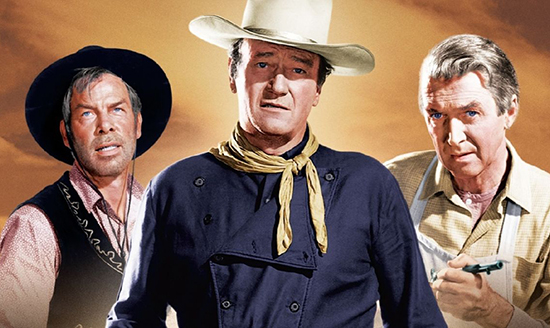Classic Hollywood: Films of ’62: The Man Who Shot Liberty Valance

Brain vs. brawn. Good guys vs. outlaws. The Man Who Shot Liberty Valance may focus on a fatal duel, but it’s definitely not a typical shoot-‘em-up Western. Leonard Maltin summarizes the tale in this review from his Classic Movie Guide: “Tenderfoot lawyer Stewart helps civilize the West, but needs help from he-man Wayne to do so. Panned and patronized upon original release, but now regarded as an American classic.”
Stewart is James Stewart, Wayne is (of course) John Wayne. They play an attorney and a rancher who love the same woman (Vera Miles) – and share a secret about who really ended the criminal reign of a sadistic killer (played with feral menace by Lee Marvin). When one of them returns to town years later to attend the other man’s funeral, the truth comes out. Or does it? If you haven’t seen it, the most famous line from the script includes this clue: “When the legend becomes fact, print the legend.”
Speaking of legends, the tagline in the Liberty Valance trailer trumpets its key selling point: Two superstars “Together for the first time.” It wouldn’t be the last time; Stewart and Wayne saddled up for Wayne’s final appearance in The Shootist. Fact is, it’s pretty darn cool seeing these Hollywood icons strut their stuff in what the New York Times calls a drama that “questions the role of myth in forging the legends of the West.”
That’s critic-speak for Liberty’s unique take on the American frontier at a pivotal moment. Would the West be ruled by violence, or by the rule of law? Ford pits literate minds against literal muscles, building suspense slowly and inexorably. Shot in black and white as a cost-cutting measure by Paramount Pictures, the story feels more intense than other Ford Westerns that were filmed in all their Technicolor splendor in Monument Valley.
As Roger Ebert puts it: “It asks the question: Does a man need to carry a gun in order to disagree or state an opinion?…[With] few characters and a gripping story, Ford dramatizes the debate about guns that still continues in many Western states…mixing in history, humorous supporting characters and a poignant romance…Without ever seeming to hurry, he doesn’t include a single gratuitous shot.”
However, even when the cameras weren’t rolling, there was tension on the set. Ford needled Wayne about not serving in World War II, asking, “How rich did you get while Jimmy was risking his life [as a bomber pilot]?” Ford also bullied Wayne about an injury that ended his college football career, taunting Wayne that castmate Woody Strode was an NFL running back and war veteran.
Sad to say, Ford’s harsh treatment of Wayne was a recurring theme over their five-decade, 14-flick screen partnership. The director was both mentor and tormentor to the actor with whom he’s most closely associated. Despite this, writer David Hofstede noted: “In a 1965 interview, John Ford was asked, ‘Are there certain of your films which you prefer?’ His response: ‘Of course. All of the films in which my friend John Wayne played the main character.’ Ford is not alone in that sentiment.”
Classic Hollywood posts appear bimonthly on The Music Hall blog.
